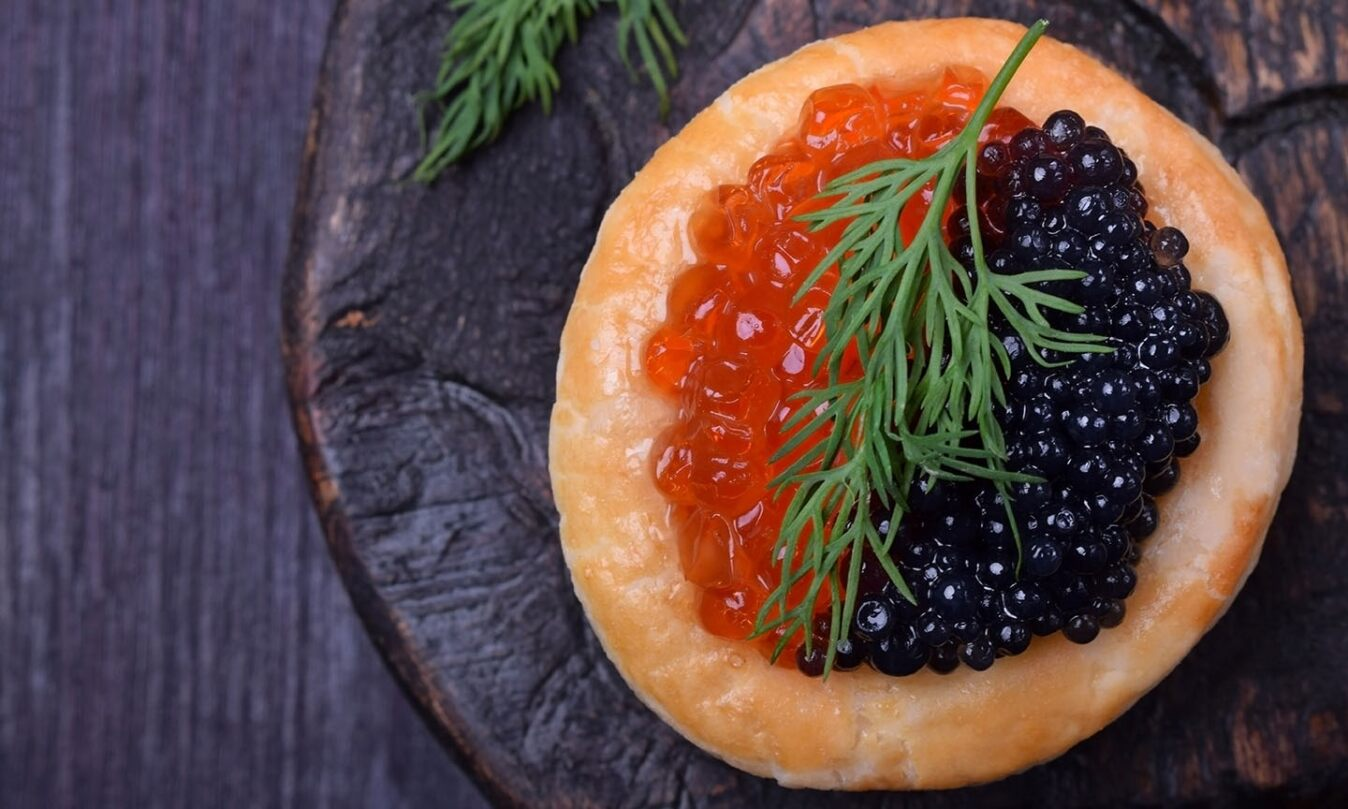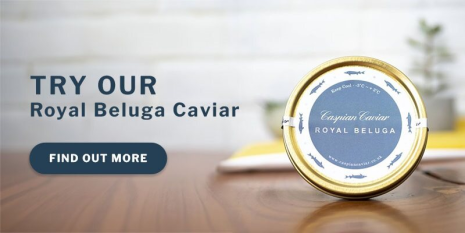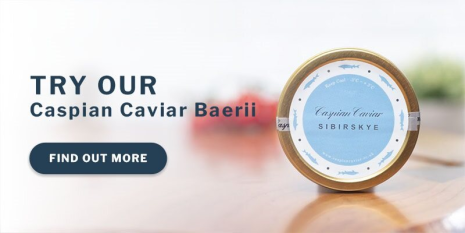
The Ultimate Guide To Caviar Types
Caviar has been a decadent treat enjoyed by fine food connoisseurs for many thousands of years. Although widely considered an acquired taste, to those accustomed to the rich flavours and unique textures, it presents an unparalleled culinary delight.
In this post, we delve into the fascinating world of caviar, exploring its varieties, which tastes best and how to eat it. Whether you’re a seasoned caviar connoisseur or you’re looking to try it for the first time, you’ll know which type to try.
The 6 Different Types of Caviar
Each variety is completely different. They all have different tastes, textures, prices, and origins. Listed below is a snapshot of the six main types of caviar you will encounter.
Oscietra Caviar
- Taste: Smooth and buttery; complex and nutty; a long finish; delicate taste.
- Colour: The colour differs across different species. Various shades of gold, amber, brown and jade.
- Texture: Firm pearls; complex mouthfeel; burst on the palate to release a rush of flavour.
- Cost: £40-£120 per ounce, depending on the species.
Produced by the Oscietra sturgeon, this is one of the most renowned varieties of caviar in the world. It is of medium cost, making it one of the more popular choices amongst connoisseurs and commercial dining establishments alike. The firm pearls are smooth and buttery in flavour, with a complex mouthfeel that releases a burst of flavour on the palate. The eggs’ colour can vary according to the species, but may range from a glistening gold to rich, dark brown.
Beluga Caviar
- Taste: Rich, buttery and creamy; mild hazelnut undertones; distinctive clean taste.
- Colour: Light grey and brown pearls with a bright glimmer.
- Texture: Soft and luxurious; melts in the mouth.
- Cost: The most expensive variety; £150-£250 per ounce.
Beluga is the king of all caviars. It is the rarest and most prized of the varieties, and it should come as no surprise to learn that it is the most expensive. Historically, it has been enjoyed by royals and wealthy elites all over the world, but nowadays, it is very difficult for even the richest people in society to obtain it. Overfishing has caused the Beluga sturgeon population to be depleted, and the pearls are illegal in many countries. They can only be bought in the UK if sourced by sustainable suppliers. But it is not just their rarity that makes Beluga caviar so expensive and sought-after. It is a distinctive rich and buttery flavour with nutty undertones, enhanced by a pearlescent glimmer. The caviar melts in the mouth and is full of nutritious fats and proteins.
Sevruga Caviar
- Taste: Intense and complex; full-bodied umami flavour; high in calories and packed with nutrients.
- Colour: Distinctive steel grey hue; pearlescent shine.
- Texture: The smallest eggs of all varieties; delicate texture; smooth and velvety.
- Cost: £40-£100 per ounce.
Sevruga is a small fish of the sturgeon family that can be found in the Caspian, Black, and Aegean seas. It is the smallest yet most calorific of the caviar varieties and is packed full of nutrients. Sevruga boasts an intense and full-bodied umami flavour and a velvety smooth texture. Sevruga pearls are notable for their small size and strikingly pearlescent grey hue. The product is particularly appealing to culinary experts and commercial chefs, as the tiny pearls make it versatile when it comes to creating artfully presented dishes.
Baerii Caviar
- Taste: Smooth and creamy; indulgent and luxurious; oyster-like brininess.
- Colour: Light browns and deep blacks.
- Texture: Medium-sized eggs with a soft and delicate texture.
- Cost: Approximately £40 per ounce.
Baerii caviar comes from the Siberian sturgeon, and is an excellent entry point for those new to caviar. It is an incredibly popular option for the everyday foodie and is much less expensive than other varieties but with a similarly indulgent taste. Baerii caviar is smooth and creamy, with a delicate texture. It is perfect for eating by itself or as a garnish for canapes. The glistening pearls are medium-sized, with colours ranging from deep blacks to light browns.
Salmon Caviar (Keta)
- Taste: A pleasant, rich and creamy taste.
- Colour: Eggs can be pale orange to dark yellow, depending on the species.
- Texture: The largest of the popular roe varieties, with a thin, delicate shell and a burst of flavour.
- Cost: £30-£50 per ounce for the most popular varieties. Other rarer types can be more expensive.
For those looking to spend a little less on their culinary delicacies, salmon presents an excellent alternative to traditional sturgeon products. Although commonly referred to as salmon caviar, it is technically incorrect to classify salmon roe in this way, as it has not been harvested from sturgeons. However, due to its comparable taste, texture, and preparation method, “salmon caviar” has become a popular term. There are many different types of salmon caviar for consumers to enjoy, all of which present their own unique flavours. It is the most affordable and popular type of fish roe and can be easily purchased in many mainstream dining establishments and delicatessens. Pink salmon caviar is the most popular, with large, pale orange eggs up to 5mm in size. The shell is thin, which creates an explosive burst of intense flavour on the palate. Trout caviar and churn salmon caviar are also popular types.
Paddlefish, Hackleback & Bowfin Caviar
- Taste: Paddlefish is earthy and floral; Hackleback is sweet, nutty, and buttery in flavour; bowfin is salty, briny, herbal, and earthy.
- Colour: Paddlefish pearls are small and firm with a steely grey exterior; Hackleback pearls are charcoal black; Bowfin roe is black, grey and relatively uniform.
- Texture: Smaller than other caviar or roe varieties, with firm pearl-like shells.
- Cost: These three varieties of roe are very affordable, with prices ranging from £10 to £30 an ounce.
There are so many different kinds of fish roe that can be enjoyed in the same way as traditional caviar. And paddlefish, hackleback and bowfin caviar are three popular alternatives that derive from North America. Of the three varieties, hackleback is the only genuine caviar product as it does indeed derive from a species of sturgeon, found predominantly in the Mississippi and Missouri Rivers of the central United States. Paddlefish and bowfin caviar are technically roe, but present a comparable flavour and texture to caviar products.
Hackleback comes from the shovelnose sturgeon, and the pearls have a distinct black charcoal colour and sweet buttery flavour. Paddlefish roe is more earthy and floral, with a small firm pearl that has a steely grey exterior. Bowfin roe is also small and pearl-like, with minimal colour variation beyond its blacks and greys. It is similar in taste to the paddlefish, with a slightly enhanced brininess.
Which Caviar Tastes The Best?
We have looked at the six main types of caviar and the flavours and textures you can expect when you sample them. But which one is truly the best? It is a common misconception that the most expensive item is always the best, but when it comes to caviar, it happens to be true.
Beluga caviar is simply unsurpassed in flavour, and this is the reason the sturgeon population is declining. There has been high demand amongst society’s elites over the years, which has created a scarcity of beluga pearls and a growing illegal trade. Fortunately, sustainable farming methods have allowed consumers to continue to purchase beluga caviar. This product may be expensive, but it is something every food-lover should try at least once in their lifetime. The taste is like nothing else, offering a rich and creamy depth enhanced by notes of hazelnut and a visually stunning shine.
But if you are new to the world of caviar, it’s understandable that you might not want to fork out huge sums for the really expensive stuff. And there are still fantastic alternatives which present a great entry point for the uninitiated.
Salmon roe, often misnomered as salmon caviar, is easily found in mainstream shops and is a great deal cheaper than traditional caviar. It can help first-time eaters to get a taste for the fishy, briny flavour and to expand their palates before moving onto the more decadent varieties. When it comes to genuine caviar, Baerii and Sevruga are cheaper options that offer a comparable rich flavour and luxurious mouthfeel.
Whatever your taste preferences and budget, it is important to try different flavours and varieties to help you determine which caviars and roes you enjoy.
How To Eat Caviar
One of the most common questions when it comes to caviar is “How do I eat it?” There are so many differing opinions on this matter, with some claiming it should be eaten with garnishes and accoutrements, while the purists claim that the best caviar should be enjoyed on its own merit.
However you choose to consume it, it is essential that caviar is served on a bed of ice to preserve it for longer and to bring out its maximum flavour. Metal spoons are unsuitable for serving, as the silverware can transfer its metallic taste to the delicate fish eggs. Mother of pearl serving spoons are the traditional method, but even a plastic spoon will do the job in a pinch.
After purchase, caviar should be stored in a fridge within its original packaging to preserve flavour.
Looking for storage tips read our guide on how to store and serve caviar for more information.
Bon Appetit!
In summary, there is a wealth of variety for both novices and connoisseurs to enjoy when it comes to caviar. Although Beluga comes out on top in taste and price, there are several excellent alternatives that won’t break the bank. Sevruga and Oscietra are slightly cheaper high-end options, while salmon roe, paddlefish, bowfin, and hackleback are perfect as an entry point to trying fish roe.
It’s good to be adventurous when trying new things, so experiment with different varieties and expand your palate. Once you get a taste for caviar, you will never look back.



